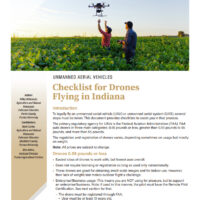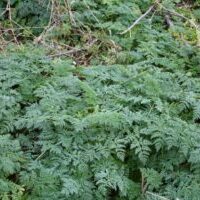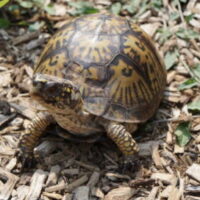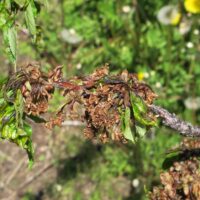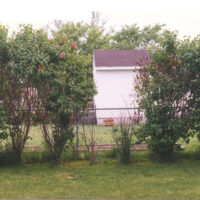 Purdue University - Extension - Forestry and Natural Resources
Purdue University - Extension - Forestry and Natural Resources
Got Nature? Blog
Wild Bulletin, Indiana Department of Natural Resources (DNR) Fish and Wildlife: Join the fun this fall and hunt one of Indiana’s gorgeous grassland birds. Quail hunting in Indiana starts on Nov. 10 and requires a Game Bird Habitat Stamp and a general hunting license. These species are present in grasslands across the state, such as Goose Pond FWA and Glendale FWA. There are no equipment restrictions for quail, but we recommend a 12- or 20-gauge shotgun with 6 to 9 shot. Remember to wear your hunter orange!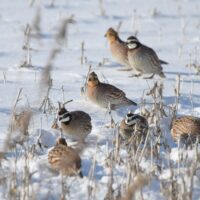
Some DNR properties may have additional regulations for quail hunting. Check with the property you’re planning to hunt for more details.
General Characteristics:
Northern bobwhites are a ground-dwelling species that only rely on flight on rare occasions. They rely on cryptic plumage color combinations and contrasts that provide excellent camouflage. They are minimally sexually dimorphic, meaning males and females have different physical characteristics. In the case of the Northern bobwhite, males have a white throat and chin, along with a white stripe above the eye extending to the back of the head. Those same areas on a female, are buffy brown in color. Underparts are tawny and white, blending with chestnut and gray. Each breast feather sports a black chevron. Upper parts of the shoulders, back, and rump, are a mixture of warm brown, cream, and shades of black. In Indiana, adult Northern bobwhites weigh an average of 180 grams (~6.5 ounces) and are about 10 inches long from bill tip to tail.
To identify and learn more about this species, please visit DNR: Fish and Wildlife: Northern Bobwhite.
Resources
Quail Habitat: Putting the Numbers in Perspective – The Education Store, Purdue Extension Resource Center
Bobwhite Quail – Indiana Department of Natural Resources
Developing a Wildlife Habitat Management Plan – The Education Store
Breeding Birds and Forest Management: The Hardwood Ecosystem Experiment and the Central Hardwoods Region – The Education Store
Small Woodlots: Important Rest Stops for Migratory Songbirds – The Education Store
Subscribe to Purdue Extension-Forestry & Natural Resources YouTube Channel, Wildlife Playlist
Ask An Expert, Purdue Extension – FNR Playlist
Indiana Department of Natural Resources
Seafood is more than just fish caught in the ocean. It includes a wide variety of product types, forms, flavors, and textures. One of the great things about using seafood is its versatility—it can be served as a main course or be used as an ingredient for appetizers, salads, and soups. Packed with important nutrients the human body needs to maintain good health, it is an excellent source of protein to include on your shopping list. Being informed about both the benefits and potential concerns with different types of seafood can help you decide which products to add to your cart or order at a restaurant.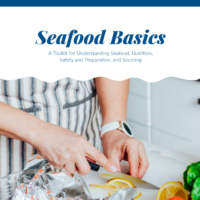
This toolkit, designed specifically for nutrition and wellness professionals and educators, will provide you with information and resources to help you talk to your clients about the complex food category known as seafood. You will learn about the basics of seafood, nutrition benefits of including seafood as part of a healthy eating pattern, concerns about safety, tips for purchasing seafood, and ideas for cooking demonstrations. We’ve included simple and tasty recipes that you can use to introduce your clients to the many flavors of fish and shellfish, links to downloadable and printable handouts, and sample social media posts that you can use to inform and inspire.
This toolkit is geared toward extension staff who teach nutrition and wellness. It includes both printable and digital elements that can be shared with clients based on interest and need.
To receive the free download and recipe visit the Purdue Extension’s resource center: The Education Store – Seafood Basics: A Toolkit for Understanding Seafood, Nutrition, Safety and Preparation, and Sourcing.
Resources:
Purdue Extension – Forestry and Natural Resources– Subscribe to the Youtube channel
Freshwater Prawn Farmed Fish Fact Sheet, The Education Store
Ask An Expert: What is Aquaculture?, Purdue Extension FNR YouTube Channel
Largemouth Bass Market Trends, Purdue Extension – Forestry and Natural Resources (FNR) YouTube Channel
Yellow Perch Farmed Fish Fact Sheet, The Education Store
Tilapia Farmed Fish Fact Sheet, The Education Store
Rainbow Trout Farmed Fish Fact Sheet, The Education Store
American Paddlefish, The Education Store
A Guide to Small-Scale Fish Processing Using Local Kitchen Facilities, The Education Store
Aquaculture Family Coloring Book Development, The Education Store
Channel Catfish, The Education Store
Eat Midwest Fish, Illinois-Indiana Sea Grant online resource hub
Amy Shambach, Aquaculture Marketing Outreach Associate
Purdue Department of Forestry and Natural Resources/Illinois Indiana Sea Grant Program
Drones can be used to assess crop health, monitor livestock, disperse cover crop seed, optimize natural resources, for public safety, and much more. Purdue Extension’s UAV pilots are flying fields, forests, and urban areas through Indiana to help farmers, land and business owners, and government officials turn images into insights. Purdue Extension’s personnel are learning how to help farmers and agricultural professionals more easily analyze and apply data from UAVs or drones.
This publication titled Unmanned Aerial Vehicles: Checklist for Drones Flying in Indiana by Purdue Extension educators explains the steps required to legally fly a UAV or UAS in Indiana.
To legally fly an unmanned aerial vehicle (UAV) or unmanned aerial system (UAS), several steps must be taken. This document provides checklists to assist you in that process. The primary regulatory agency for UAVs is the Federal Aviation Administration (FAA). FAA puts drones in three main categories: 0.55 pounds or less, greater than 0.55 pounds to 55 pounds, and more than 55 pounds. The regulation and registration of drones varies, depending sometimes on usage but mostly on weight.
To receive the free download visit the Purdue Extension’s resource center: The Education Store – Unmanned Aerial Vehicles: Checklist for Drones Flying in Indiana.
For more information regarding Purdue Extension and Purdue Agriculture’s outreach through the agricultural use of unmanned aeiral vehicles (UAVs) view Purdue Extension-UAV.
Resources:
Integrated Digital Forestry Initiative (iDiF)
Creating a Wildlife Habitat Management Plan for Landowners, The Education Store
Purdue Extension Pond and Wildlife Management Website, Purdue Extension
Timber Harvesting and Logging Practices for Private Woodlands, The Education Store, Purdue Extension’s resource center
Investing in Indiana Woodlands, The Education Store
Woodland Wildlife Management, The Education Store
ID That Tree, Playlist, Purdue Extension – Forestry & Natural Resources (FNR) YouTube Channel
Woodland Stewardship for Landowners Video Series, Playlist, Purdue Extension – FNR YouTube Channel
Frost Seeding Native Grasses and Forbs with a Drone (UAV): Lessons Learned, Purdue Extension Forestry & Natural Resources
A New Drone Supports Pollinator Efforts, Purdue Extension Forestry & Natural Resources
Nikky Witkowski, Agriculture and Natural Resources
Extension Educator, Purdue University
Mark Carter, Agriculture and Natural Resources
Extension Educator, Purdue University
Alex Helms, Assistant Director,
Purdue Agricultural Centers
MyDNR, Indiana’s Outdoor Newsletter: The latest Hunting Guide for 2023-2024 is available. The Division of Fish & Wildlife is excited to show off the many methods and precautions needed to be successful during hunti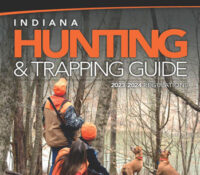 ng season.
ng season.
The 2023-2024 Indiana Hunting & Trapping Guide is essential in making sure you are hunting legally and safely, as it provides information on what, when, where, why, and how to hunt properly.
Indiana hunting and trapping opportunities include: deer, wild turkey, furbearers, small game, waterfowl and migratory birds along with other game birds. For licenses, where to hunt, and more information view: Hunting and Trapping, IN DNR, Department of Fish and Wildlife.
To subscribe to the newsletter visit MyDNR Email Newsletter.
Explore the outdoors with Indiana Department of Natural Resources in their 24 state parks, Indiana State Parks and Lakes.
Resources:
How to Score Your White-tailed Deer, video, The Education Store, Purdue Extension Resource Center
White-Tailed Deer Post Harvest Collection, video, The Education Store
Age Determination in White-tailed Deer, video, The Education Store
How to Build a Plastic Mesh Deer Exclusion Fence, The Education Store
Managing Your Woods for White-Tailed Deer, The Education Store
Bovine Tuberculosis in Wild White-tailed Deer, The Education Store
Help With Wild Turkey Populations, Video, Purdue Extension – Forestry and Natural Resources YouTube Channel
Turkey Brood Reporting, Indiana Department of Natural Resources (IDNR)
Wild Turkey, Indiana Department of Natural Resources (IDNR)
Wild Turkey Hunting Biology and Management, Indian Department of Natural Resources (IDNR)
Subscribe to Purdue Extension-Forestry & Natural Resources YouTube Channel, Wildlife Playlist
Indiana Department of Natural Resources, Department of Fish & Wildlife
Purdue Landscape Report: I have lost count of the number of times I’ve witnessed people working with chainsaws in shorts, a tank top, and flip flops with maybe a pair of earbuds, and it makes me cringe every time. According to the CDC, over 36,000 chainsaw-related injuries a year are reported with annual medical costs of more than $350 million (Johnson, 2023). Wearing the proper personal protective equipment (PPE) can help prevent accidents and injuries (Fig. 1). PPE is there to protect you from head to toe and if you are investing in a chainsaw, it doesn’t take much more to invest in the proper PPE. Including a work shirt and pants, if you’re using a chainsaw you should wear protection for your head, eyes and ears, hands, legs, and feet, most of which can be found at your local hardware store or home center.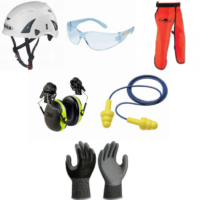
Protecting your head means using a helmet, not a baseball cap or bandanna. Depending on the type of work you’re doing there is a risk of being struck by wood or branches or if kickback occurs, sending the chainsaw back towards your head. Safety glasses will help keep sawdust and other debris out of your eyes and should be stamped with Z87.1, showing they conform to ANSI safety regulations. Normal glasses and sunglasses are not rated for being struck and can shatter, sending broken lenses into your eyes. Ear protection can be in the form of plugs or muffs and should be rated to reduce noise to appropriate levels when worn properly.
Most modern chainsaws have built-in anti vibration technology to reduce fatigue, but having a nice pair of work gloves will still help to protect your hands and grip. Gloves will help protect against debris and are also good to wear for chainsaw maintenance. Although not about PPE, another note on protecting your hands when operating a chainsaw includes the proper use of the chain brake. Injuries can occur on the right hand because operators will remove it from the back handle to activate the chain brake with the palm of their hand and miss it, putting their hand on the still moving chain. Injuries on either hand can happen when one handing a saw while using your other hand to brace or manage what you are cutting and losing control. The chain brake is designed to be engaged by popping your left wrist forward while maintaining a grip with both hands on the handles.
To protect your legs some form of chaps or chap pants are needed. Prices can range from around $40 for a pair of wrap-chaps that can be worn over your work pants up to around $400 for a high-end pair of chap pants that are a stand-alone work pant replacement. Whichever you choose to wear, the protection should be from the top of your thigh to the top of your foot and wrap around your calf. Care should be taken to keep them clean from gas and oil and if they are ever damaged by a chainsaw, chaps should be discarded and replaced. Once the protective material has been damaged the safety has been compromised. Chainsaw boots are also available to protect your lower legs and feet but are expensive and can be heavy. A sturdy work boot should be worn at the very least while staying alert to how close the chainsaw is coming to you. And please, no open-toed shoes.
Whatever the task, if you are going to do your own chainsaw work, then I implore you to wear your PPE from head to toe. I know it’s hot and can get uncomfortable, but all it takes is one mistake to send you to the ER. If you feel the job is beyond your capabilities you can always contact an ISA certified arborist at Find an Arborist through the treesaregood.org website.
To view this full article and other Purdue Landscape Report articles, please visit Purdue Landscape Report.
Subscribe and receive the newsletter: Purdue Landscape Report Newsletter.
Resources:
The Purdue Landscape Report
A Woodland Management Moment, Playlist, Purdue Extension – Forestry and Natural Resources (FNR) Youtube Channel
Conservation Tree Planting: Steps to Success, Purdue Extension – FNR Youtube Channel
Forest Improvement Handbook, The Education Store
Find an Arborist website, Trees are Good, International Society of Arboriculture (ISA)
Caring for storm-damaged trees/How to Acidify Soil in the Yard – In the Grow, Purdue Extension
Moist soil and rotten roots makes it easy for trees to come crashing down – Fox 59 News
Tree Risk Management – The Education Store, Purdue Extension’s resource center
Mechanical Damage to Trees: Mowing and Maintenance Equipment – The Education Store
Trees and Electric Lines – The Education Store
Tree Support Systems, The Education Store
Corrective Pruning for Deciduous Trees, The Education Store
Tree Installation: Process and Practices, The Education Store
Ben McCallister, Urban Forestry Specialist
Purdue Forestry & Natural Resources
Purdue Landscape Report: Poison hemlock was introduced to North America as a garden/ornamental plant. It is a native of Europe, and it is a member of the Apiaceae (parsley) family.
Purdue experts Bill Johnson and Marcelo Zimmer wrote about poison hemlock in a Purdue Pest & Crop newsletter.
They wrote that poison hemlock can be noticed very early in the spring every year, as it is typically one of the first weeds to green up, usually in late February to early March if temperatures are favorable. They said the largest threat of this weed is the toxicity of its alkaloids if ingested by livestock or humans, but it can also reduce the aesthetic value of landscapes and has been reported to creep into no-till corn and soybean fields as well.
Purdue Extension’s fact sheet on poison hemlock states that it can also be found along roads, streams, trails, ditches, forest edges, and waste areas.
The Purdue experts said that poison hemlock is a biennial weed that exists as a low-growing herb in the first year, and bolts to three to eight feet tall in the second year, when it produces flowers and seed. It is often not noticed until the bolting and reproductive stages of the second year. Poison hemlock is often confused with wild carrot, but can be distinguished by its lack of hairs and purple blotches that occur on the stems.
The experts pointed out that poison hemlock contains five alkaloids that are toxic to humans and livestock, and it can be lethal if ingested. They warn that the plant’s alkaloids may also be absorbed through the skin, so if you find yourself hand-pulling poison hemlock, it would be a good idea to wear gloves. All parts of the plants contain the toxic alkaloids with levels being variable throughout the year. Symptoms of toxicity include nervousness, trembling, and loss of coordination followed by depression, coma, and/or death. Initial symptoms will occur within a few hours of ingestion.
For history buffs, the Greek philosopher Socrates was sentenced to death by hemlock poisoning.
Cases of poisoning due to poison hemlock ingestion are rare as the plants emit a mousy odor that makes it undesirable and unpalatable to livestock and humans. Consumption and toxicity in animals usually occur in poorly managed or overgrazed pastures where animals are forced to graze poison hemlock because desirable forage is lacking.
To view this full article and other Purdue Landscape Report articles, please visit Purdue Landscape Report.
Subscribe and receive the newsletter: Purdue Landscape Report Newsletter.
Resources:
The Purdue Landscape Report
Purdue Pest & Crop Newsletter
Invasive Plant Species Fact Sheets: Poison Hemlock, The Education Store, Purdue Extension Resource Center
Poison Hemlock (Conium maculatum), United States Department of Agriculture (USDA)
Invasive plants: impact on environment and people, The Education Store, Purdue Extension’s resource center
Woodland Management Moment: Invasive Species Control Process, Video, Purdue Extension – Forestry and Natural Resources (FNR) YouTube Channel
Invasive Species, Playlist, Purdue Extension – FNR YouTube Channel
What are invasive species and why should I care?, Got Nature? Blog, Purdue Extension – FNR
Report Invasive, Purdue College of Agriculture – Entomology
John Woodmansee, Extension Educator, Whitely County
Purdue Extension
Wild Bulletin, Indiana Department of Natural Resources (DNR) Fish and Wildlife: The Eastern box turtle (Terrapene carolina) is a species of hinge-shelled turtle that lives on forested land in Indiana. Box turtles are long-lived, slow to mature and have few offspring per year. This, coupled with the high mortality rate of box turtles being hit on roads, has resulted in Eastern box turtles being a species of special concern in Indiana.
Eastern box turtles are listed as a species of special concern in Indiana due to population declines involving habitat loss, road mortality, and collection for pets. If you see one this summer, be sure to keep these guidelines in mind:
- Eastern box turtles may not be collected from the wild; however, if you accidentally catch an Eastern box turtle from Indiana from the wild, please contact the Division of Fish & Wildlife at DFW@dnr.IN.gov; do not release it into the wild. Its chances of survival are low, and it could transmit diseases to other wild Eastern box turtles.
- Sick or injured Eastern box turtles should be left in the wild. Don’t fret—box turtles are surprisingly resilient to damage and disease. If left alone, they will likely heal on their own. If a box turtle appears severely injured, it can be given to a licensed rehabilitator or licensed veterinarian.
If you see a wild Eastern box turtle crossing a busy road, you can pick it up and move it to the other side of the road in the direction it was facing. DNR appreciates your efforts to conserve wildlife.
To identify and learn more about the Eastern box turtle, please visit the DNR: Fish and Wildlife: Eastern Box Turtle website
Resources
Turtles of Indiana, The Education Store
Appreciating Reptiles and Amphibians in Nature, The Education Store
Forestry Management for Reptiles and Amphibians: A Technical Guide for the Midwest, The Education Store
The Nature of Teaching, Unit 3: Reptiles, Amphibians, and the Scientific Method, The Education Store
Partners in Amphibian and Reptile Conservation (PARC)
Ask An Expert, Purdue Extension – FNR Playlist
Indiana Department of Natural Resources
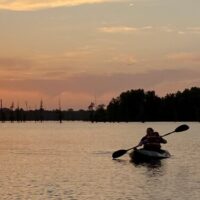 MyDNR, Indiana’s Outdoor Newsletter: Become a Paddlecraft Wildlife Index volunteer and help DNR by documenting the wildlife you observe while on the water from June 1 to July 31. After signing up online, you will be mailed a packet with details on how to participate.
MyDNR, Indiana’s Outdoor Newsletter: Become a Paddlecraft Wildlife Index volunteer and help DNR by documenting the wildlife you observe while on the water from June 1 to July 31. After signing up online, you will be mailed a packet with details on how to participate.
Paddling is a great way to enjoy Indiana’s natural beauty, observe wildlife, and connect with nature. Indiana paddlers have a unique opportunity to observe wildlife while enjoying Indiana’s countless water resources. Indiana DNR would like more information about the wildlife that spend time around Indiana’s waterways. The Indiana Paddlecraft Wildlife Index compiles wildlife observations from people who use canoes, kayaks, or other non-motorized paddlecraft on Indiana’s waterways. Volunteer paddlers can help by completing a paddling trip postcard documenting the wildlife they observed while floating from June 1 to July 31.
Newsletter can be found online May: DNR: Communications: MyDNR Email Newsletter (in.gov)
For more information please visit Paddlecraft Wildlife Index – MyDNR.
Resources:
Yellow Perch Farmed Fish Fact Sheet, The Education Store, Purdue Extension’s resource center
Rainbow Trout Farmed Fish Fact Sheet, The Education Store
American Paddlefish, The Education Store
Aquaculture Family Coloring Book Development, The Education Store
Eat Midwest Fish, Illinois-Indiana Sea Grant online resource hub
Protect Your Waters, U.S. Fish and Wildlife Service & U.S. Coast Guard
What are invasive species and why should I care?, Got Nature? Blog, Purdue Extension – Forestry and Natural Resources
Aquatic Invasive Species in the Great Lakes: The Quagga Mussel, Purdue Extension – Forestry & Natural Resources (FNR) Got Nature? Blog
Aquatic Invaders in the Marketplace, Illinois-Indiana Sea Grant (IISG)
Invasive Species, Playlist, Purdue Extension – FNR YouTube Channel
Nongame and Endangered Wildlife, Indiana Department of Natural Resources
Subscribe to Purdue Extension-FNR YouTube Channel
Indiana Department of Natural Resources, Department of Fish & Wildlife
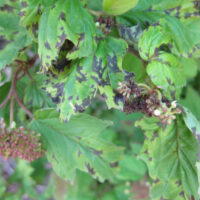
Bacterial leaf spots are often angular with chlorotic halos, as seen on this high bush-cranberry. Photo by Janna Beckerman.
Purdue Landscape Report: Pseudomonas syringae pv. syringae is an opportunistic bacterial pathogen that attacks a diversity of woody ornamental plants. The bacteria cause flower blights, cankers, shoot blights, and diebacks.
Symptoms
Symptoms often begin as expanding leaf spots. On lilac and viburnum, small spots expand to irregularly shaped brown lesions with yellow halos (Fig. 1). For most other hosts (cherry, pear, basswood, dogwood, hydrangea, high bush-cranberry, mountain-ash), infected leaves turn reddish brown or black and usually remain on the branch after they die (Fig. 2). As the bacteria spread into woody tissue, dark, sunken sections of the stem (cankers) expand, working their way back toward the trunk from infected leaves and flowers. Leaves attached to a cankered branch will wilt while the tip of the affected branch curls and droops like a shepherd’s crook (Fig. 3). Cloudy droplets of sticky fluid (ooze) may accumulate on leaf tips, leaf surfaces, stems, and even infected fruit.
Image of infected flowers result in blossom blast.
Figure 2. Infected flowers result in blossom blast. The continued growth of the bacteria can result in cankering and blight. Photo by George Sundin.
Life Cycle
The bacteria overwinter and persist in cankers, along with asymptomatic bud and twig tissue. In presence of water and warming temperatures, bacteria multiply and may ooze from infected tissue. Wind-driven rain, insect, or mechanical pruning spread Pseudomonas. Bacteria enter the plant through flowers or injury.
Management
All bacterial pathogens, including Pseudomonas, invade flowers or wounded tissue. To prevent or minimize the risk of infection:
- Use disease-free plants and budwood.
- Prune in the late winter/early spring.
- When pruning, do not mix pruning to shape woody ornamentals with pruning to manage disease.
- When pruning to remove infected shoots, be sure to disinfect shears between plants.
- Minimize overhead irrigation when possible to minimize splashing and pathogen spread.
- Avoid over-fertilization practices that drive excess succulent growth.
- Avoid late season fertilization practices that prevent plants from achieving timely dormancy and promote freeze damage and/or winter injury (Fig. 4).
- Choose zone appropriate plants to avoid freeze damage and/or winter injury.
- Choose disease resistant plants, when available. The following lilac varieties were found to be resistant over a four-year trial: Donald Wyman, Royalty, Superba, Miss Kim, Edmund Boisier, Victor Lemoine, Dwarf Korean, Mme. Antoine Buchner Isabella, Sensation, Anna Amhof, Krasavitska Moskvy, Michael Buchner, and Alphonse Lavallée.
Foliar sprays of some copper-based bactericides (e.g., Camelot, Kocide, and Nu-Cop) were found to reduce disease incidence in trials on lilac (Vey and Palmer, 2018). Avoid using copper under cool, humid conditions to reduce the risk of phytotoxicity and damaging plants. Copper resistant populations of Pseudomonas syringae have been reported in other crops (vegetables, stone fruit). Products containing acibenzolar have provided inconsistent control in multiple trials but is labeled for use. Use of quaternary-ammonium disinfestants (KleenGrow) have been found to reduce bacterial populations and disease incidence and should be considered as part of any rotation with copper products. Due to the diversity of copper products, be sure to test for phytotoxicity issues prior to large scale treatment of crops.
To view this article and other Purdue Landscape Report articles, please visit Purdue Landscape Report.
Subscribe and receive the newsletter: Purdue Landscape Report Newsletter.
Resources:
The Purdue Landscape Report
Purdue Landscape Report Facebook Page
Find an Arborist website, Trees are Good, International Society of Arboriculture (ISA)
Phytophthora Diseases in Ornamentals, The Education Store, Purdue Extension’s resource center
Root Rot in Landscape Plants, The Education Store
Symptoms and Signs for Plant Problem Diagnosis, The Education Store
Tree Defect Identification, The Education Store
Tree Pruning Essentials, Publication & Video, The Education Store
Shrubs and Woody Vines of Indiana and the Midwest, The Education Store
Tree Risk Management, The Education Store
Equipment Damage to Trees, Got Nature? Blog
Tree wounds and healing, Got Nature? Blog
ID That Tree, Purdue Extension-Forestry & Natural Resources (FNR) YouTube playlist
Southwest Damage, Scalding, or Frost Cracking – Landscape Report
Subscribe to Purdue Extension-FNR YouTube Channel
Janna Beckerman, Professor of Plant Pathology
Purdue Department of Botany
 MyDNR: Annually, more than 14,000 deer-vehicle collisions are reported in Indiana. If you live where deer are found, especially in suburban areas or where field and forest meet, it is important to know ways to reduce the likelihood of a collision and what to do if you are involved in one. While you can’t eliminate the possibility of running into a deer on the road, you can minimize the risk of severe damage to you or your vehicle.
MyDNR: Annually, more than 14,000 deer-vehicle collisions are reported in Indiana. If you live where deer are found, especially in suburban areas or where field and forest meet, it is important to know ways to reduce the likelihood of a collision and what to do if you are involved in one. While you can’t eliminate the possibility of running into a deer on the road, you can minimize the risk of severe damage to you or your vehicle.
Deer movements are not random, and the likelihood of seeing deer near roads varies by time of day and month. Deer are most active when many people are commuting to and from work, resulting in increased collisions. While your chance of hitting a deer varies, in general, deer-vehicle collisions are most likely to occur during these conditions:
- At dawn and dusk when deer are most active.
- From September through December, particularly October and November during deer mating season as bucks cross roads more frequently and are less cautious when crossing.
For more information view the Indiana DNR printable PDF (.144mb) Deer-Vehicle Collisions and You.
Resources:
Watch out for deer on the roads, Got Nature? Post, Purdue Extension – Forestry and Natural Resources (FNR)
A Woodland Management Moment – Deer Fencing, Purdue Extension – FNR YouTube Video
Woodland Stewardship for Landowners: Managing Deer Damage to Young Trees, Purdue Extension – FNR YouTube Video
Ask an Expert: Wildlife Food Plots, Purdue Extension – FNR YouTube Video
How to Build a Plastic Mesh Deer Exclusion Fence, The Education Store, Purdue Extension resource center
Deer Harvest Data Collection, Got Nature? Blog, Purdue Extension – FNR
Handling Harvested Game: Episode 4, Cutting, Grinding & Packaging, Purdue Extension – FNR YouTube Video
Indiana Department of Natural Resources
Recent Posts
- Cicadas in Spring! – Purdue Landscape Report
Posted: April 9, 2024 in Forestry, Plants, Safety, Wildlife - New Deer Impact Toolbox
Posted: April 7, 2024 in Forestry, Land Use, Plants, Publication, Safety, Wildlife, Woodlands - Help Research Chronic Wasting Disease – Wild Bulletin
Posted: April 3, 2024 in Disease, Forestry, How To, Safety, Wildlife, Woodlands - How to Interact with Young Wildlife This Spring, MyDNR
Posted: March 28, 2024 in Forestry, How To, Safety, Wildlife, Woodlands - Rare Cicada Emergence: Q&A with Purdue Bug Expert
Posted: March 25, 2024 in Alert, Forestry, Plants, Safety, Wildlife - Barn Owls in Goose Pond Fish & Wildlife Area Nest Box, MyDNR
Posted: March 4, 2024 in Forestry, Land Use, Safety, Wildlife, Woodlands - Cicadas Are Making a Rare Appearance in Indiana in 2024, Indy Star
Posted: January 20, 2024 in Forestry, Plants, Safety, Wildlife - Learn About Lead: Avoiding Lead Ingestion in Wild Game, Wild Bulletin
Posted: December 8, 2023 in Alert, Disease, How To, Safety, Wildlife - Wildlife Wins of 2023, Wild Bulletin
Posted: in Aquaculture/Fish, Aquatic/Aquaculture Resources, How To, Safety, Wildlife - MyDNR: Hunting Season Update
Posted: December 4, 2023 in Forestry, How To, Safety, Wildlife
Archives
Categories
- Alert
- Aquaculture/Fish
- Aquatic/Aquaculture Resources
- Ask the Expert
- Christmas Trees
- Community Development
- Disease
- Drought
- Forestry
- Forests and Street Trees
- Gardening
- Got Nature for Kids
- Great Lakes
- How To
- Invasive Animal Species
- Invasive Insects
- Invasive Plant Species
- Land Use
- Natural Resource Planning
- Nature of Teaching
- Plants
- Podcasts
- Ponds
- Publication
- Safety
- Timber Marketing
- Uncategorized
- Urban Forestry
- Webinar
- Wildlife
- Wood Products/Manufacturing
- Woodland Management Moment
- Woodlands
